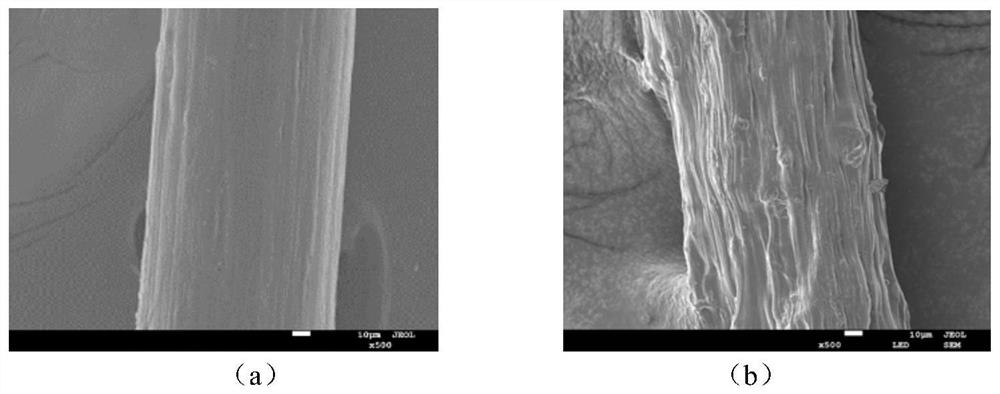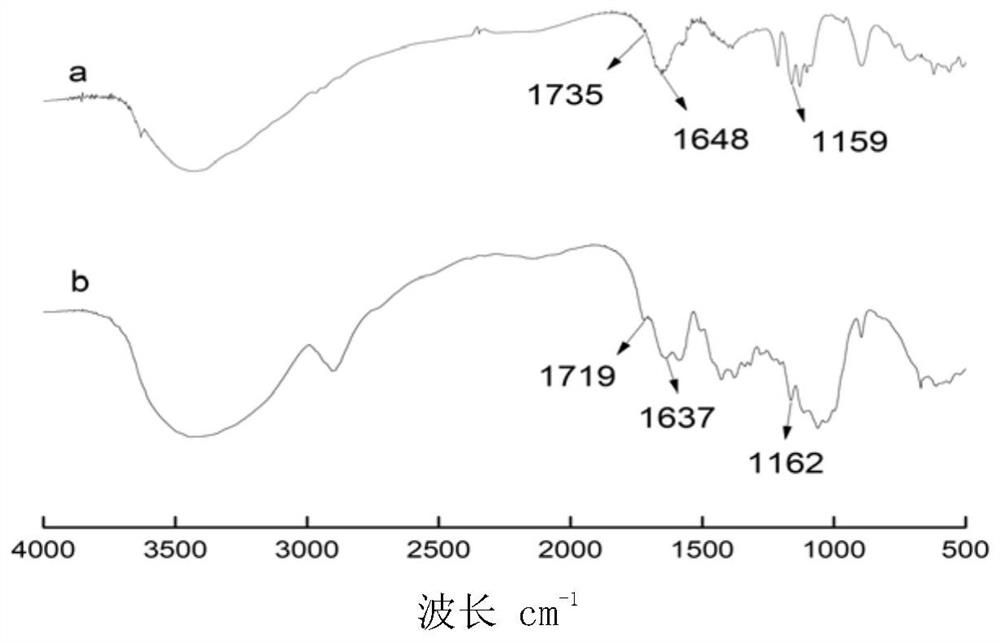A method for preparing modified cotton stalk sheath microcrystalline cellulose/graphene oxide composite fiber
A composite technology of microcrystalline cellulose and graphene, which is applied in the direction of artificial filaments made of cellulose derivatives, fiber chemical characteristics, chemical instruments and methods, etc., can solve problems such as environmental pollution and resource waste, and achieve easy solution Difficult agglomeration recovery, short mass transfer distance, and high adsorption selectivity
- Summary
- Abstract
- Description
- Claims
- Application Information
AI Technical Summary
Problems solved by technology
Method used
Image
Examples
Embodiment 1
[0032] The preparation method of modified cotton stalk sheath microcrystalline cellulose / graphene oxide composite fiber of the present invention, it comprises the steps:
[0033] (1) Modification: the cotton stalk skin microcrystalline cellulose (prepared with reference to the method in Example 1 in Patent Application No. 201710847371.7) was placed in 15wt% NaOH solution, stirred magnetically at 60°C for 2 hours, and the product Wash and filter repeatedly with deionized water and dry in an oven at 80°C for 3 hours. The alkali-treated cotton stalk sheath microcrystalline cellulose fiber was added to the melted maleic anhydride, the mass ratio of maleic anhydride to maleic anhydride was 1:6, the temperature was heated to 65°C and mechanical stirring was continued for 2 hours. After stirring, drop pyridine (accounting for 3% of the quality of the modified cotton stalk skin microcrystalline cellulose) and continue to heat up to 90°C and continue to stir for 6 hours. Drying in an ...
Embodiment 2
[0042] The preparation method of modified cotton stalk sheath microcrystalline cellulose / graphene oxide composite fiber of the present invention, it comprises the steps:
[0043] (1) Modification: the cotton stalk skin microcrystalline cellulose (prepared with reference to the method in Example 1 in Patent Application No. 201710847371.7) was placed in 15wt% NaOH solution, stirred magnetically at 60°C for 2 hours, and the product Wash and filter repeatedly with deionized water and dry in an oven at 80°C for 3 hours. The alkali-treated cotton stalk sheath microcrystalline cellulose fiber was added to the melted maleic anhydride, the mass ratio of maleic anhydride to maleic anhydride was 1:6, the temperature was heated to 65°C and mechanical stirring was continued for 2 hours. After stirring, drop pyridine (accounting for 3% of the quality of cotton stalk skin microcrystalline cellulose) and continue to heat up to 90°C and continue to stir for 6 hours. Drying in medium temperatu...
Embodiment 3
[0052] The preparation method of modified cotton stalk sheath microcrystalline cellulose / graphene oxide composite fiber of the present invention, it comprises the steps:
[0053] (1) Modification: the cotton stalk skin microcrystalline cellulose (prepared with reference to the method in Example 1 in Patent Application No. 201710847371.7) was placed in 15wt% NaOH solution, stirred magnetically at 60°C for 2 hours, and the product Wash and filter repeatedly with deionized water and dry in an oven at 80°C for 3 hours. The alkali-treated cotton stalk sheath microcrystalline cellulose fiber was added to the melted maleic anhydride, the mass ratio of maleic anhydride to maleic anhydride was 1:6, the temperature was heated to 65°C and mechanical stirring was continued for 2 hours. After stirring, drop pyridine (accounting for 3% of the quality of cotton stalk skin microcrystalline cellulose) and continue to heat up to 90°C and continue to stir for 6 hours. Drying in medium temperatu...
PUM
| Property | Measurement | Unit |
|---|---|---|
| particle diameter | aaaaa | aaaaa |
| adsorption capacity | aaaaa | aaaaa |
| adsorption capacity | aaaaa | aaaaa |
Abstract
Description
Claims
Application Information
 Login to View More
Login to View More - R&D
- Intellectual Property
- Life Sciences
- Materials
- Tech Scout
- Unparalleled Data Quality
- Higher Quality Content
- 60% Fewer Hallucinations
Browse by: Latest US Patents, China's latest patents, Technical Efficacy Thesaurus, Application Domain, Technology Topic, Popular Technical Reports.
© 2025 PatSnap. All rights reserved.Legal|Privacy policy|Modern Slavery Act Transparency Statement|Sitemap|About US| Contact US: help@patsnap.com



